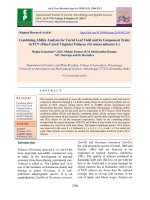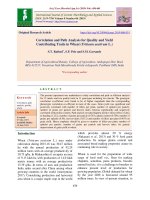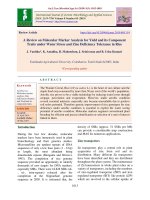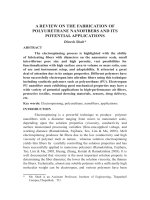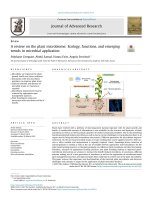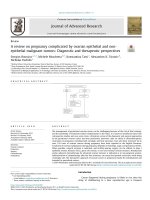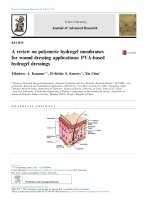A review on molecular marker analysis for yield and its component traits under water stress and zinc deficiency tolerance in rice
Bạn đang xem bản rút gọn của tài liệu. Xem và tải ngay bản đầy đủ của tài liệu tại đây (244.19 KB, 6 trang )
Int.J.Curr.Microbiol.App.Sci (2019) 8(5): 1013-1018
International Journal of Current Microbiology and Applied Sciences
ISSN: 2319-7706 Volume 8 Number 05 (2019)
Journal homepage:
Review Article
/>
A Review on Molecular Marker Analysis for Yield and its Component
Traits under Water Stress and Zinc Deficiency Tolerance in Rice
J. Vanitha*, K. Amudha, R. Mahendran, J. Srinivasan and R. Usha Kumari
Tamilnadu Agricultural University, Coimbatore, Tamil Nadu 641003, India
*Corresponding author
ABSTRACT
Keywords
Aerobic rice,
Molecular marker
analysis, Zinc
deficiency tolerance
and Yield and its
component traits
Article Info
Accepted:
10 April 2019
Available Online:
10 May 2019
The Wonder Cereal, Rice (Oryza sativa L.) is the heart of our culture and the
staple food crop consumed by more than 50 per cent of the world’s population.
Aerobic rice proves to be a viable technology by reducing water losses through
seepage, percolation and evaporation. However, under aerobic condition
several essential nutrients, especially zinc became unavailable due to positive
soil redox potential. Therefore genetic improvement of rice genotypes for zinc
deficiency under aerobic condition is essential to exploit the water saving
potential of aerobic condition. Molecular markers augment conventional plant
breeding for efficient and precise identification or selection of a trait of interest
linked to them.
Introduction
During the last few decades, molecular
markers have been immensely used in plant
biotechnology and their genetics studies.
Microsatellites are tandem repeats of DNA
sequences of only a few base pairs (1 - 6 bp)
in length, the most abundant being
dinucleotide repeats (Morgante and Olivievi,
1993). The completion of rice genome
sequence provided an opportunity to identify
thousands of new targets for DNA markers,
especially SSRs. There were 18,828 SSRs (di, tri-, tetra-repeats) released after the
completion of the Nipponbare genome
sequence in 2005. It is estimated that, the
density of SSRs (approx. 51 SSRs per Mb)
can provide a considerable map construction
and MAS for numerous applications.
Zinc transporters
Zn transporters play a central role in plant
acquisition of zinc from soil and its
distribution. Many different Zn transporters
have been identified and they are distributed
throughout the plant system. The maintenance
of Zn homeostasis in whole plant relies on a
variety of transporters, including the members
of zinc-regulated transporter (ZRT) and iron
regulated transporter (IRT) like protein (ZIP)
which are involved in the cellular uptake of
1013
Int.J.Curr.Microbiol.App.Sci (2019) 8(5): 1013-1018
Zn from soil to root cells at soil root interface
(Colangelo and Guerinot, 2006); natural
resistance associated macrophage protein
(NRAMP) families which regulate the proton
driven transport of Zn and other transition
metal ions (Thomine et al., 2000). OsZIP1,
OsZIP3, OsZIP4, OsZIP5 and OsZIP8 are
reported to encode rice plasma membrane Zn
transporters and are induced by Zn deficiency
(Ramesh et al., 2003; Ishimaru et al., 2005;
Yang et al., 2009; Lee et al., 2010a, b and
Suzuki et al., 2012). OsZIP1, OsZIP3, and
OsZIP4 were expressed in the vascular
bundles in shoots and in the vascular bundles
and epidermal cells in roots (Ramesh et al.,
2003 and Ishimaru et al., 2006).
QTL for yield and its component traits for
zinc deficiency tolerance in rice
Yadav et al., 1997 used a DH population of
105 lines derived from a cross between IR64
(irrigated indica) and Azucena (upland
japonica) and identified QTL regions for
maximum root length (MRL) and deep root to
shoot ratio (DR/SR) on chromosome 1, 2, 5,
6, 7, 8, and 9 using RFLP markers.
Avendano (2000) identified a QTL for zinc
deficiency tolerance using mapping (RILs)
population of Madhukar and IR26 on
chromosome 5 between markers RM164 and
RM87 showing a variation 61.9 per cent with
a LOD value of 3.45.
Kamoshita et al., (2008) identified QTLs
using in the RILs of IR 58821/IR 52561 for
root traits. They found 2, 12 and 8 QTLs for
shoot biomass, deep root morphology and
root thickness respectively with LOD scores
ranging from 2.0 to 12.8. Phenotypic variation
explained by the QTLs ranged from 6 per cent
to 30 per cent. QTLs linked to seminal root
length, adventitious root number, lateral root
length, lateral root number and the relative
parameters under flooding and upland
conditions were located in RI lines developed
from IR1552/Azucena (Zheng et al., 2003). A
number of quantitative trait loci (QTLs) have
been identified in various rice populations for
various root traits including basal root
thickness (Zheng et al., 2000; Price et al.,
2000; Shen et al., 2001; Steele et al., 2006;
Gomez et al., 2009; Kanagaraj et al., 2010;
Steele et al., 2013).
Gomez et al., (2009) reported QTLs linked to
physio-morphological and plant production
traits under drought stress using 177 F6
recombinant inbred (RI) lines of Bala ×
Azucena. The RI lines showed significant
variation for physio-morphological and plant
production traits under stress. A total of 24
QTL were identified for various traits under
stress, which individually explained 4.6 to
22.3 per cent phenotypic variation. Composite
interval mapping detected three markers viz.,
RM3894,
RG409
and
G1073
on
chromosomes 3 and 8 linked to grain yield
under drought stress, respectively explaining
22.3, 17.1 and 10.9 per cent of phenotypic
variation. QTL for leaf drying, days to 50 per
cent flowering and number of productive
tillers under drought stress co-located at
certain of these regions. Further, QTL for
several root traits overlapped with QTL for
grain yield under stress in these RI lines,
indicating the pleiotropic effects of root trait
QTL on rice performance under stress.
Thanh et al., (2006) mapped QTLs for root
traits (maximum root length, root thickness,
root weight to shoot and deep root weight to
shoot ratios) using AFLP and SSR markers in
upland rice using a recombinant inbred (RI)
population derived from a cross between
Vietnamese upland rice accessions. The QTL
on chromosome 12 flanked by SSR marker
RM270 and AFLP marker AVM28.17 and
QTL on chromosome 2 flanked by markers
AVM43.1-RM250were
identified
for
maximum root length explaining phenotypic
1014
Int.J.Curr.Microbiol.App.Sci (2019) 8(5): 1013-1018
variance of 7.2 and 8.5 per cent respectively.
For number of total tillers, the QTL on
chromosome 6 flanked by markers RM50AVM29.2 were identified with the phenotypic
variance of 34.70 per cent. For root weight to
shoot ratio, QTL was located on chromosome
9 with phenotypic variation of 10.2 per cent
flanked by RM242-RM288 markers. In
addition to QTLs for root traits, QTL for plant
height (PH) on chromosome 1 flanked by
markers
AVM26.9-AVM26.4
with
phenotypic variation of 9.70 per cent was
identified.
Wissuwa et al., (2006) using a mapping
population of IR64 and Jalmanga reported a
QTL Zmt12 for zinc deficiency induced
mortality on chromosome 12 flanked by
markers CDO344-1–RG543-1 with adjusted
R2 value of 11.60 and QTL Zdm3 for shoot
dry matter on chromosome 3 flanked by
RZ675–P1M9-10 markers with adjusted R2
value of 18.10. It was considered as a key
factor for tolerance to Zn deficiency
explaining a major portion of the variation for
mortality with a LOD value of 6.40.
Stangoulis et al., (2007) detected two QTLs
for
zinc
concentration
located
on
chromosomes 1 and 12, explaining 15 per
cent and 13 per cent of the total phenotypic
variation with a LOD of 3.4 and 3.1
respectively, using a doubled haploid
mapping population between IR64 and
Azucena.
Garcia-Olivera et al., (2009) identified two
QTLs qZN-8 and qZn-12 for Zn content using
backcross populations (85 BILs) obtained by
crossing Teqing (Oryza sativa) and elite wild
rice (O. rufipogon) using 179 SSR markers.
They found that the QTL near marker RM152
on chromosome 8 accounted for the largest
proportion of phenotypic variation (11–19 per
cent) for Zn content, whereas the QTL that
was located on chromosome 12 accounted for
9 per cent phenotypic variation.
Venuprasad et al., (2009) identified two large
effect QTLs DTY3.1 and DTY2.1 for grain
yield under water stress in rice using RILs
from the cross APO/swarna. Two markers
RM234 and RM416 located on chromosome
2 and 3 respectively were shown via bulk
segregant analysis to be strongly associated
with yield under water stress. The QTL linked
to RM416 (DTY3.1) had a large effect on
yield under severe low land drought stress
explaining about 31 per cent of genetic
variance of the trait (P < 0.0001). It also
explained considerable variance for yield
under aerobic environment. The QTL linked
to RM234 (DTY2.1) had a highly significant
effect on grain yield under aerobic
environment explaining 16 per cent of genetic
variance for the trait.
Ramya et al., (2010) concluded that the
region between RM160 – RM215 on
chromosome 9, contributing to maximum root
depth under both control and drought
condition. Primers RM242 and RM296 lying
between marker interval RM160 – RM215 on
chromosome 9 were reported to be linked
with zinc deficiency tolerance indicating
maximum root depth plays an important role
in zinc deficiency tolerance mechanism.
Vikram et al., (2011) reported a major QTL
qDTY1.1 for grain yield under water stress on
chromosome 1 flanked by markers RM11943
and RM431 using three mapping populations.
In combined analysis over two years
qDTY1.1 showed an additive effect of 29.30
per cent, 24.30 per cent and 16.10 per cent of
mean yield in N22 and swarna, N22 and IR64
and N22 and MTU100 respectively under
water stress.
The major effect QTL for grain yield,
qDTY1.1 was identified to show an effect
under water stress in several genetic
backgrounds. Ghimire et al., (2012) also
detected qDTY1.1 in two RIL populations
1015
Int.J.Curr.Microbiol.App.Sci (2019) 8(5): 1013-1018
derived from donor dhagaddesi crossed to
swarna and IR64 consistently over two
seasons. A large effect QTL associated with
grain yield in aerobic environments was
identified in three genetic backgrounds. Apo/
swarna, Apo/IR72 and vandana/IR72 using
bulk segregant analysis (BSA). Two closely
linked rice microsatellite markers RM510 and
RM19367 located on chromosome 6 were
found to be associated with yield under
aerobic soil conditions in all three
backgrounds. The QTL linked to this marker
qDTY6.1 was mapped to a 2.2 cM region
between RM19367 and RM3805 at a peak
LOD score of 32 in the Apo/swarna
population.
Sankar et al., (2013) reported that RM242 and
RM296 primers present on chromosome 9 at
locus 73.3cM and 20.4cM respectively were
also found to be linked with QTL for zinc
deficiency tolerance. In his study, according
to root scan data obtained from field condition
samples showing tolerance had more root
length and root volume, which indicated that
zinc deficiency tolerance character is directly
or indirectly associated with the root length
and root volume.
In conclusion, one of the most important uses
of QTL mapping is to apply them in marker
assisted selection (MAS) for genetic
improvement of quantitative traits. Once the
tightly linked markers have been identified, the
traits can be selected indirectly using MAS.
The reported map position of gramene
database was used to estimate the QTLs
following the inclusive composite interval
mapping of additive and dominant (ICIMADD) method. The QTL analysis resulted in
the identification of many QTLs for zinc
deficiency tolerance in rice. Hence these QTLs
may be used in Marker Assisted Selection
programme (MAS) for zinc deficiency
tolerance under aerobic system.
References
Avendano, B.S., 2000. Tagging high zinc
content in the grain, and zinc
deficiency tolerance genes in rice
(Oryza sativa L.) using simple
sequence repeats (SSR). M.Sc (Ag.)
thesis Laguna Collage, Los Banos.
Colangelo, E.P,. and M.L. Guerinot. 2006.
Put the metal to the petal: metal
uptake and transport throughout
plants. Curr. Opin. Plant Biol., 9: 322330.
Garcia-Olivera. A.L., T. Lubin, F. Yongcai
and S. Chuanqing. 2009. QTL
mapping for mineral nutrients in rice
grain using introgression lines
population. In: National Evaluation
Central for Agricultural Wild Plant
(Rice). Key Laboratory of Crop
Genetic Improvement and Genome of
Ministry of Agri., Beijing, China.
Ghimire, K.H., A. Q. Lenie, V. Prashant,
B.P.S. Mallikarjuna, D. Shalabh, A.
Helaluddin, E. H. Jose, H.B. Teresita
and K. Arvind. 2012. Identification
and mapping of a QTL (qdty1.1) with
a consistent effect on grain yield under
drought. Field Crops Res., 131: 88–96.
Gomez, M., N.M. Boopathi, S.S. Kumar, T.
Ramasubramanian, Z. Chengsong, P.
Jeyaprakash, A. Senthil and R.C.
Babu. 2009. Molecular mapping and
location of QTLs for droughtresistance traits in indica rice (Oryza
sativa L.) lines adapted to target
environments. Acta Physiol. Plant.,
32: 355 - 364.
Ishimaru, Y., M. Suzuki, T. Kobayashi, M.
Takahashi, H. Nakanishi, S. Mori and
N.K. Nishizawa. 2005. OsZIP4, a
novel zinc-regulated zinc transporter
in rice. J. Exp. Bot., 56: 3207-3214.
Ishimaru, Y., M. Suzuki, T. Tsukamoto, K.
Suzuki, M. Nakazono, T. Kobayashi,
Y. Wada, S. Watanabe, S. Matsuhashi
1016
Int.J.Curr.Microbiol.App.Sci (2019) 8(5): 1013-1018
and M. Takahashi. 2006. Rice plants
take up iron as
an Fe3+‐
phytosiderophore and as Fe2+. Plant J.,
45: 335-346.
Kamoshita, A., R.C. Babu, N.M. Boopathi
and S. Fukai. 2008. Phenotypic and
genotypic analysis
of drought
resistance traits for development of
rice cultivars adapted to rainfed
environments. Field Crops Res., 109:
1 – 23.
Kanagaraj, P.K., S.J. Prince, J.A. Sheeba,
K.R. Biji, S.B. Paul, A. Senthil and
R.C. Babu. 2010. Microsatellite
markers linked to drought resistance in
rice (Oryza sativa L.) Curr. Sci., 98: 6.
Lee, S., H.J. Jeong, S.A. Kim, J. Lee, M.L.
Guerinot and G. An. 2010b. Oszip5 is
a plasma membrane zinc transporter in
rice. Plant Mol. Biol., 73: 507-517.
Lee, S., S.A. Kim, J. Lee, M.L. Guerinot and
G. An. 2010a. Zinc deficiencyinducible Oszip8 encodes a plasma
membrane-localized zinc transporter
in rice. Mol. Cells., 29: 551-558.
Morgante, M. and A.M. Olivieri. 1993. PCRamplified microsatellites as markers in
plant genetics. Plant J., 3: 175-182.
Price, A.H., K.A. Steele, B.J. Moore, P.B.
Barraclough and L.J. Clark. 2000. A
combined RFLP and AFLP linkage
map of upland rice (Oryza sativa L.)
used to identify QTLs for root
penetration ability. Theor. Appl.
Genet., 100: 49 – 56.
Ramesh, S.A., R. Shin, D.J. Eide and D.P.
Schachtman. 2003. Differential metal
selectivity and gene expression of two
zinc transporters from rice. Plant
Physiol., 133: 126-134.
Ramya, M, M. Raveendran, Sathiyamoorthy
and J. Ramalingam. 2010. In silico
analysis of drought tolerant genes in
rice. Int. J. Biol. Sci., 1(3): 36-40.
Sankar S.R., E., S.B. Verulkar, R.R. Saxena,
S. Xalxo, S.K. Verma and P. Deepthi.
2013. Identification of qtls for
tolerance to zinc deficiency in rice
(Oryza sativa L). IJSID., 3(3): 317325.
Shen, L., B. Courtois, K. McNally, S. Robin
and Z. Li. 2001. Evaluation of nearisogenic lines of rice introgressed with
QTLs for root depth through markeraided selection. Theor. Appl. Genet.,
103: 75-83.
Stangoulis, J., C.R.B. Lam, M.W. Young, C.
Robin and D. Graham. 2007.
Quantitative trait loci for phytate in
rice grain and their relationship with
grain
micronutrient
content.
Euphytica. 154: 289–294.
Steele, K. A, A.H. Price, J.R. Witcombe, R.
Shrestha, B.N. Singh, J.M. Gibbons
and D.S. Virk. 2013. QTLs associated
with root traits increase yield in
upland rice when transferred through
marker-assisted selection. Theor.
Appl. Genet., 126: 101-108.
Steele, K.A., A.H. Price, H.E. Shashidhar and
J.R. Witcombe. 2006. Marker-assisted
selection to introgress rice QTLs
controlling root traits into an Indian
upland rice variety. Theor. Appl.
Genet., 112: 208 – 21.
Suzuki, M., K. Bashir, H. Inoue, M.
Takahashi, H. Nakanishi and N.K.
Nishizawa. 2012. Accumulation of
starch in Zn-deficient rice. Rice., 5: 18.
Thanh, N.D., N.T.K. Lien, P.Q. Chung, T.Q.
Trong, L.T.B. Thuy and H. Nguyen.
2006. Mapping QTLs associated with
root traits related to drought resistance
in Vietnamese upland rice. ASEAN J.
Sci. Tech. Devel., 23(4): 323-332.
Thomine, S., R. Wang, J.M. Ward, N.M.
Crawford and J.I. Schroeder. 2000.
Cadmium and iron transport by
members of a plant metal transporter
family in Arabidopsis with homology
to nramp genes. Proc. Natl. Acad.
1017
Int.J.Curr.Microbiol.App.Sci (2019) 8(5): 1013-1018
Sci., 97: 4991-4996.
Venuprasad, R., M.E. Bool, C.O. Dalid, J.
Bernier, A. Kumar, G.N. Atlin. 2009.
Genetic loci responding to two cycles
of divergent selection for grain yield
under drought stress in a rice breeding
population. Euphytica. 167: 261–269.
Vikram, P., B.P. Mallikarjuna Swamy, S.
Dixit, H.U. Ahmed, M.T.S. Cruz,
A.K. Singh and Arvind Kumar. 2011.
qDTY1.1, a major QTL for rice grain
yield under reproductive-stage drought
stress with a consistent effect in
multiple elite genetic backgrounds.
Biomed. Genet., 12: 89.
Wissuwa, M., M. Abdelbagi, Ismail and S.
Yanagihara. 2006. Effects of zinc
deficiency on rice growth and genetic
factors contributing to tolerance.
Plant. Physiol., 142: 731–741.
Yadav, R., B. Courtois, N. Huang and G.
McLaren. 1997. Mapping genes
controlling root morphology and root
distribution on a double-haploid
population of rice. Theor. Appl.
Genet., 94: 619–632.
Yang, X., J. Huang, Y. Jiang and H.S. Zhang.
2009.
Cloning
and
functional
identification of two members of the
ZIP (Zrt, Irt-like protein) gene family
in rice (Oryza sativa L.). Mol. Biol.
Rep., 36: 281-287.
Zheng, H., R.C. Babu, M.S. Pathan, L. Ali, N.
Huang, B. Courtois and H.T. Nguyen.
2000. Quantitative trait loci for rootpenetration ability and root thickness
in rice: comparison of genetic
backgrounds. Genome. 43: 53 - 61.
How to cite this article:
Vanitha, J., K. Amudha, R. Mahendran, J. Srinivasan and Usha Kumari, R. 2019. A Review on
Molecular Marker Analysis for Yield and its Component Traits under Water Stress and Zinc
Deficiency Tolerance in Rice. Int.J.Curr.Microbiol.App.Sci. 8(05): 1013-1018.
doi: />
1018
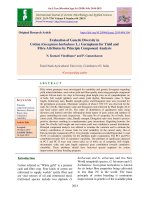
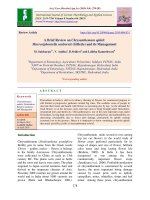
![Generation mean analysis for yield, yield components and MYMV disease scores in blackgram [Vigna mungo (L).Hepper]](https://media.store123doc.com/images/document/2020_01/09/medium_kiu1578565010.jpg)
